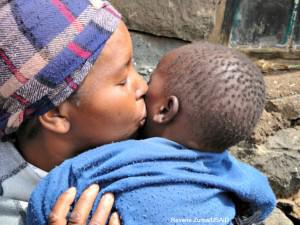Children benefit from ‘power of prevention’ – but not adults


More moms in the region are receiving essential HIV medication to stop the virus infecting their babies, according to a new report published on Tuesday (12 July) by the Joint United Nations Programme on HIV/AIDS (UNAIDS).
Since 2010 there has been a massive 66% drop in new HIV infections among children in eastern and southern Africa with an estimated 56 000 occurring in 2015. This “impressive decline” is largely thanks to “the rapid increase in coverage of services for prevention of mother-to child transmission [PMTCT] from 61% in 2010 to 90% in 2015”.
The “Prevention gap report” identifies trends in new HIV infections around the globe and shows that while new infections amongst adults have stopped declining, infections among children have dropped by over 70% since 2001.
Preventing HIV in children: South Africa’s success
PMTCT includes a range of services to reduce the risk of transmission from a mother to her baby – primarily providing her with effective antiretroviral therapy.
According to South Africa’s National Institute for Communicable Diseases, the country has made dramatic progress with its PMTCT programme which started in 2004. At that time over 20 percent of babies born to HIV positive mothers became infected. But, by 2014 this figure had plummeted to 1.8 percent.
Although the region (eastern and southern Africa) is home to 6.2% of the world’s population, it contains half the planet’s people living with HIV. According to the report, 46% of new HIV infections in 2015 occurred in the region – with South Africa alone responsible for almost half of these.
Girls and young women most at risk
“We are sounding the alarm. If there is a resurgence in new HIV infections now, the epidemic will become impossible to control.”
Young woman in particular are at a high risk of HIV-infection due to a combination of gender-inequality, stigma and high rates of transactional sex.
The report noted that “with committed efforts” the region stands a chance of reaching the UNAIDS targets for 2020 amongst children, with 90 percent tested, 90 percent on treatment and 90 percent achieving virological suppression (when the amount of virus in the blood declines to undetectable levels). But, “adult infections are not declining fast enough” to reach these goals in time.
“We are sounding the alarm,” said UNAIDS executive director Michel Sidibé in a press release. “If there is a resurgence in new HIV infections now, the epidemic will become impossible to control.”
The organisation also noted that reaching adolescent girls and young women, “especially in sub-Saharan Africa, will be a key factor in ending the AIDS epidemic”.
An edited version of this story was also published on Health24.com.
Author
Republish this article
This work is licensed under a Creative Commons Attribution-NoDerivatives 4.0 International License.
Unless otherwise noted, you can republish our articles for free under a Creative Commons license. Here’s what you need to know:
You have to credit Health-e News. In the byline, we prefer “Author Name, Publication.” At the top of the text of your story, include a line that reads: “This story was originally published by Health-e News.” You must link the word “Health-e News” to the original URL of the story.
You must include all of the links from our story, including our newsletter sign up link.
If you use canonical metadata, please use the Health-e News URL. For more information about canonical metadata, click here.
You can’t edit our material, except to reflect relative changes in time, location and editorial style. (For example, “yesterday” can be changed to “last week”)
You have no rights to sell, license, syndicate, or otherwise represent yourself as the authorized owner of our material to any third parties. This means that you cannot actively publish or submit our work for syndication to third party platforms or apps like Apple News or Google News. Health-e News understands that publishers cannot fully control when certain third parties automatically summarise or crawl content from publishers’ own sites.
You can’t republish our material wholesale, or automatically; you need to select stories to be republished individually.
If you share republished stories on social media, we’d appreciate being tagged in your posts. You can find us on Twitter @HealthENews, Instagram @healthenews, and Facebook Health-e News Service.
You can grab HTML code for our stories easily. Click on the Creative Commons logo on our stories. You’ll find it with the other share buttons.
If you have any other questions, contact info@health-e.org.za.
Children benefit from ‘power of prevention’ – but not adults
by Amy Green, Health-e News
July 13, 2016
MOST READ
Prolonged power outage leaves hospitals in the dark for two days
There’s more to self-care than scented candles or massages, it’s a key public health tool
Malaria can’t be beaten without political will and more funding
Access to clean water and stable electricity could go a long way to addressing rising food poisoning in SA
EDITOR'S PICKS
Related



